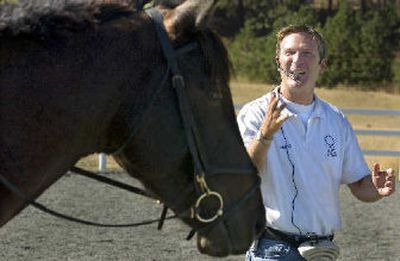Stewart back in saddle again

Daniel Stewart is spinning in circles talking about rhythm, balance and for some reason, he keeps mentioning thumbtacks.
Stewart, a world-renowned equestrian coach, is in the middle of one of his many clinics he taught this weekend at the Daniel Stewart Clinic hosted by Spokane Sport Horse Farm and the Cabinet Mountains Pony Club.
With his microphone headset securely in place, he is free to walk around the arena and give individual attention to his riders and has so much to say that it is difficult for anyone to get a word in. No one seems to mind taking expert advice though.
“Thumbtacks, you guys,” Stewart says. “Pay attention to the thumbtacks.”
Apparently, they are hypothetical thumbtacks.
“The thumbtack reference is because riders are supposed to pretend there are thumbtacks on their saddle,” Pony Club instructor Julie Stephens says. “It forces them to think about how they are sitting and their movement on the horse.”
The 43-year-old Stewart, who resides in Andalusia, Spain, is coaching his fifth clinic in four years in Eastern Washington. Spokane is one of eight stops he makes on the West Coast. In his 12-day stay he will also visit Seattle, Portland and make five stops in California.
Five years ago Stewart was the keynote speaker at the U.S. National Equestrian Conference in Las Vegas. It was there Stewart met Stephens. The two became friends and she asked if he would do a clinic in Spokane.
“That first year we had such a high turnout I did two clinics,” Stewart said. “(Julie) did such a good job of putting it together that we made it an annual thing.”
His resume, which is quite impressive, makes a person wonder what he is doing in Spokane, not exactly an equestrian hotbed. Stewart travels for 27 hours before arriving, he buys his own plane ticket and he sees approximately 20 riders at this year’s clinic.
“I come this way for a couple of reasons,” Stewart said. “My family lives in Calgary (Alberta), so I visit them when I come. But it is also because of the reception I get from Spokane and the riders. They really are one of the most fun groups I get to coach.”
Most recently, Stewart led the U.S. Endurance team at the 2002 World Equestrian Games in Spain and the U.S. Paralympics Dressage team at the 2003 World Championships in Belgium. He also coached the U.S. Paralympics Dressage team at the 2004 Athens Games.
Beyond coaching, the Canadian-American was previously an internationally-ranked show jumper until 1998, when he was asked to lead the American team to the Olympics.
“I had accomplished what I wanted to as a rider,” Stewart said. “When I was contacted to coach, I switched and it was the right choice. I have always felt proud to teach what I have learned to other hopefuls.”
Stewart, who grew up in Calgary, earned his degree from the University of Calgary in 1985 in sport science with a minor in sport psychology. It was there he developed what he is perhaps most known for – his position analysis philosophy.
In his position analysis clinic, Stewart digitally records riders for 30 minutes followed by a 90-minute frame-by-frame analysis of the video.
“The video is helpful because it identifies possible improvements that the rider can make,” Stewart explains. “My clinic is about improving the rider, not horse and rider, so with a recording I have tangible evidence of what I am trying to get them to accomplish. It’s about improving the mind and body of the rider.
“Once we identify the imperfection and understand how to improve it, we get back on the horse and fix it so we can work on what we just talked about with the video. As much as we trust our coaches in athletics, it’s very different to see with your own eyes what you are doing wrong. They need visual feedback.”
Feedback is not in short supply at the clinic. Stewart is constantly watching and instructing his riders to make even minor improvements.
“Everyone has room to improve,” Stewart said. “The most minor changes can make a big difference. For example, someone who is right-handed must understand how that will affect turning the horse.”
Stewart’s reward for all of his hard work is what he gets back from his riders, and it has been that way since he coached the Paralympics team, his proudest professional accomplishment.
“The people I got to work with were so incredible,” Stewart said. “Some are deaf, blind or paralyzed. They have been dealt so much emotional and physical trauma and they don’t let that interfere.”
Stewart will not be with the team in Beijing. His professional pride is trumped by his proudest accomplishment in life – his family. And with 14-hour workdays, a landslide of traveling commitments and a newborn baby, Stewart had to set priorities.
“It was too much time away from my family,” Stewart said. “I had to sit down after Athens and reevaluate things in my life. Coaching is very exciting for me, but I’m tired and I have traveled the world for years now. My family is number one always.”
So when he works, he works hard, putting in long hours and traveling to far-off places. But at home in southern Spain, it’s all about Severine, his Swiss wife of six years, and their two children, Luca, 4, and newborn Emma.
Don’t expect this family man to stop altogether. Stewart said he will definitely be back next year.
“The riders I draw in Spokane are some of the most fun and enjoyable people to work with,” Stewart said. “For me to keep coming, they have to give back. As long as they keep giving back, I will continue to visit this pleasant group.”